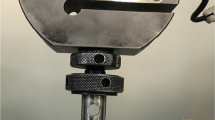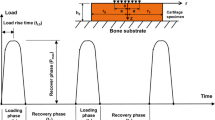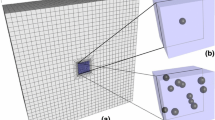Abstract
Experimental evidence suggests that cells are extremely sensitive to their mechanical environment and react directly to mechanical stimuli. At present, it is technically difficult to measure fluid pressure, stress, and strain in cells, and to determine the time-dependent deformation of chondrocytes. For this reason, there are no data in the published literature that show the dynamic behavior of chondrocytes in articular cartilage. Similarly, the dynamic chondrocyte mechanics have not been calculated using theoretical models that account for the influence of cell volumetric fraction on cartilage mechanical properties. In the present investigation, the location- and time-dependent stress-strain state and fluid pressure distribution in chondrocytes in unconfined compression tests were simulated numerically using a finite element method. The technique involved two basic steps: first, cartilage was approximated as a macroscopically homogenized material and the mechanical behavior of cartilage was obtained using the homogenized model; second, the solution of the time-dependent displacements and fluid pressure fields of the homogenized model was used as the time-dependent boundary conditions for a microscopic submodel to obtain average location- and time-dependent mechanical behavior of cells. Cells and extracellular matrix were assumed to be biphasic materials composed of a fluid phase and a hyperelastic solid phase. The hydraulic permeability was assumed to be deformation dependent and the analysis was performed using a finite deformation approach. Numerical tests were made using configurations similar to those of experiments described in the literature. Our simulations show that the mechanical response of chondrocytes to cartilage loading depends on time, fluid boundary conditions, and the locations of the cells within the specimen. The present results are the first to suggest that chondrocyte deformation in a stress-relaxation type test may exceed the imposed system deformation by a factor of 3–4, that chondrocyte deformations are highly dynamic and do not reach a steady state within about 20 min of steady compression (in an unconfined test), and that cell deformations are very much location dependent. © 2000 Biomedical Engineering Society.
PAC00: 8719Rr, 8717Aa, 0270Dh
Similar content being viewed by others
References
Ateshian, G. A., W. H. Warden, J. J. Kim, R. P. Grelsamer, and V. C. Mow. Finite deformation biphasic material properties of bovine articular cartilage from confined compression experiments. J. Biomech.30:1157-1164, 1997.
Athanasiou, K. A., M. P. Rosenwasser, J. A. Buckwalter, T. I. Malinin, and V. C. Mow. Interspecies comparisons in in situ intrinsic mechanical properties of distal cartilage. J. Orthop. Res.9:330-340, 1991.
Bachrach, N. M., B. Valhmu, E. Stazzone, A. Ratcliffe, W. M. Lai, and V. C. Mow. Changes in proteoglycan synthesis of chondrocytes in articular cartilage are associated with the time-dependent changes in their mechanical environment. J. Biomech.28:1561-1569, 1995.
Buschmann, M. D., Y. A. Gluzband, A. J. Grodzinsky, J. H. Kimmura, and E. Hunziker. Chondrocytes in agarose culture synthesize a mechanically functional extracellular matrix. J. Orthop. Res.10:745-758, 1992.
Buschmann, M. D., Y. A. Gluzband, A. J. Grodzinsky, and E. Hunziker. Mechanical compression modulates matrix biosynthesis in chondrocyte/agarose culture. J. Cell. Sci.108:1497-1508, 1995.
Christensen, R. M. Mechanics of Composite Materials. Malabar, FL: Krieger, 1991.
Clark, A. L., W. Herzog, J. R. Matyas, and L. D. Barclay. Chondrocyte deformation resulting from in situ compression of articular cartilage. Proc. XVII Congr. Int. Soc. Biomech. (ISB'99), 1999, p. 339.
Eshelby, J. D. The continuum theory of lattice defects. edited by F. Seitz and D. Turnbull. In: Progress in Solid State Physics; New York: Academic, 1956, Vol. 3, p. 79.
Glanz, J.Force-carrying web pervades living cell. Science276:678-679, 1997.
Gray, M. L., A. M. Pizzanelli, A. J. Grodzinsky, and R. C. Lee. Mechanical and physiochemical determinants of the chondrocyte biosynthetic response. J. Orthop. Res.6:777-792, 1988.
Guilak, F., Compression-induced changes in the shape and volume of the chondrocyte nucleus. J. Biomech.28:1529-1541, 1995.
Guilak, F., and V. C. Mow. Determination of the mechanical response of the chondrocyte in situ using confocal microscopy and finite element analysis. Adv. Biomech. ASME BED-22:21–23, 1992.
Guilak, F., A. Ratcliffe, and V. C. Mow. Chondrocyte deformation and local tissue strain in articular cartilage: A confocal microscopy study. J. Orthop. Res.13:410-421, 1995.
Hashin, Z., and S. Shtrikman. A variational approach to the theory of the effective magnetic permeability of multiphase materials. J. Appl. Phys.33:3125-3131, 1962.
Holmes, M. H.Finite deformation of soft tissue: analysis of a mixture model in uni-axial compression. J. Biomech. Eng.108:372-381, 1986.
Holmes, M. H., and V. C. Mow. The nonlinear characteristics of soft gels and hydrated connective tissues in ultrafiltration. J. Biomech.23:1145-1156, 1990.
Hou, J. S., M. H. Holmes, W. M. Lai, and V. C. Mow. Boundary conditions at the cartilage-synovial fluid interface for joint lubrication and theoretical verifications. J. Biomech. Eng.111:78-87, 1989.
Lai, W. M., V. C. Mow, and V. Roth. Effects of nonlinear strain-dependent permeability and rate of compression on the stress behavior of articular cartilage. ASME J. Biomech. Eng.103:61-66, 1981.
IMSL. User's Manual of IMSL Mathematical Library. Chap. 5: Differential Equations. IMSL, Houston: IMSL, 1990.
Jones, W. R., H. P. Ting-Beall, G. M. Lee, S. S. Kelley, R. M. Hochmuth, and F. Guilak. Mechanical properties of human chondrocytes and chondrons from normal and osteoarthritic cartilage. Trans. Orthop. Res. Soc.22:1-199, 1997.
McLaughlin, R.A study of the differential scheme for composite materials. Int. J. Eng. Sci.15:237-244, 1977.
Mow, V. C., S. C. Kuei, W. M. Lai, and C. G. Armstrong. Biphasic creep and stress relaxation of articular cartilage: Theory and experiment. ASME J. Biomech. Eng.102:73-84, 1980.
Mow, V. C., N. M. Bachrach, L. A. Setton, and F. Guilak. Stress, Strain, Pressure and Flow Fields in Articular Cartilage and Chondrocytes. Edited by: V. C. Mow, F. Guilak, R. Tran-Son-Tay, and R. M. Hochmuth. In: Cell Mechanics and Cellular Engineering, New York: Springer, 1994, pp. 345–379.
Norris, A. N.A differential scheme for the effective moduli of composites. Mech. Mater.4:1-16, 1985.
Saamanen, A. M., M. Tammi, I. Kiviranta, J. Jurvelin, and H. J. Helminen. Maturation of proteoglycan matrix in articular cartilage under increased and decreased joint loading–A study in young rabbits. Conn. Tissue Res.16:163-175, 1987.
Sah, R. L-Y., A. J. Grodzinsky, A. H. K. Plaas, and J. D. Sandy. Effects of static and dynamic compression on matrix metabolism in cartilage explants. Edited by K. E. Kuettner, R. Schleyebach, J. G. Peyron, and V. Hascall. In: Articular Cartilage and Osteoarthritis, New York: Raven, 1991, pp. 373–383.
Schinagl, R. M., D. Gurskis, A. C. Chen, and R. L. Sah. Depth-dependent confined compression modulus of full-thickness bovine articular cartilage. J. Orthop. Res.15:499-506, 1997.
Schneiderman, R., D. Keret, and A. Maroudas. Effects of mechanical and osmotic pressure on the fate of glycosaminoglycan synthesis in the human adult femoral head cartilage: An in vitro study. J. Orthop. Res.4:393-408, 1986.
Shin, D., and K. A. Athanasiou. Biomechanical properties of the individual cell. Trans. Orthop. Res. Soc.22:1-352, 1997.
Stockwell, R. A. Biology of Cartilage Cells. Cambridge: Cambridge University Press, 1979.
Torzilli, P. A., R. Grigiene, C. Huang, S. M. Friedman, S. B. Doty, A. L. Boskey, and G. Lust. Characterization of cartilage metabolic response to static and dynamic stress using a mechanical explant test system. J. Biomech.30:1-9, 1997.
Wong, M., P. Wuethrich, M. D. Buschmann, P. Eggli, and E. Hunziker. Chondrocyte biosynthesis correlates with local tissue strain in statically compressed adult articular cartilage. J. Orthop. Res.15:189-198, 1997.
Wu, J. Z., W. Herzog, and M. Epstein. Evaluation of the finite element software ABAQUS for biomechanical modelling of biphasic tissues. J. Biomech.31:165-169, 1998.
Wu, J. Z., W. Herzog, and M. Epstein. Modeling of location-and time-dependent deformation of chondrocytes during cartilage loading. J. Biomech.32:563-572, 1999.
Zimmerman, R. W.Elastic moduli of a solid containing spherical inclusions. Mech. Mater.12:17-24, 1991.
Rights and permissions
About this article
Cite this article
Wu, J.Z., Herzog, W. Finite Element Simulation of Location- and Time-Dependent Mechanical Behavior of Chondrocytes in Unconfined Compression Tests. Annals of Biomedical Engineering 28, 318–330 (2000). https://doi.org/10.1114/1.271
Issue Date:
DOI: https://doi.org/10.1114/1.271




